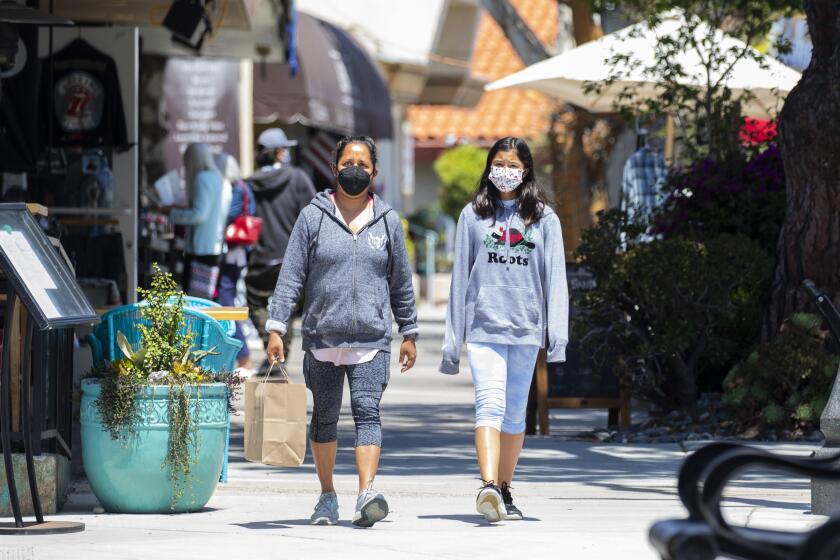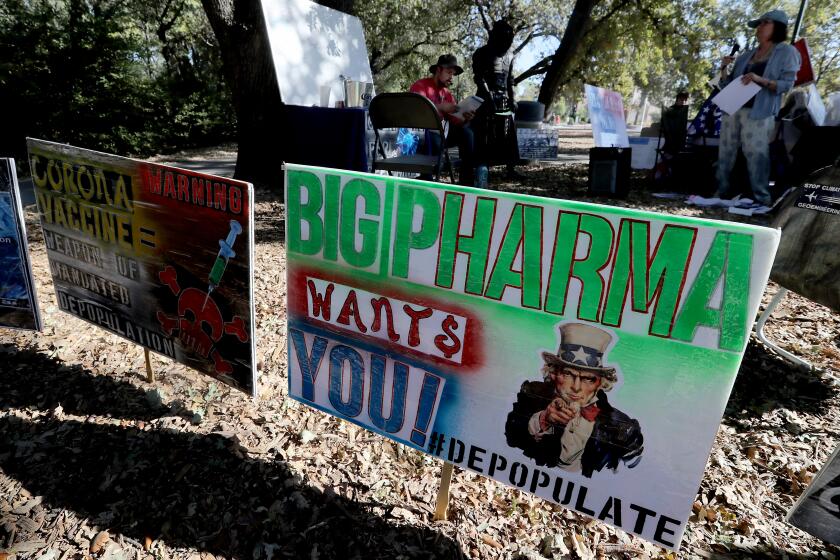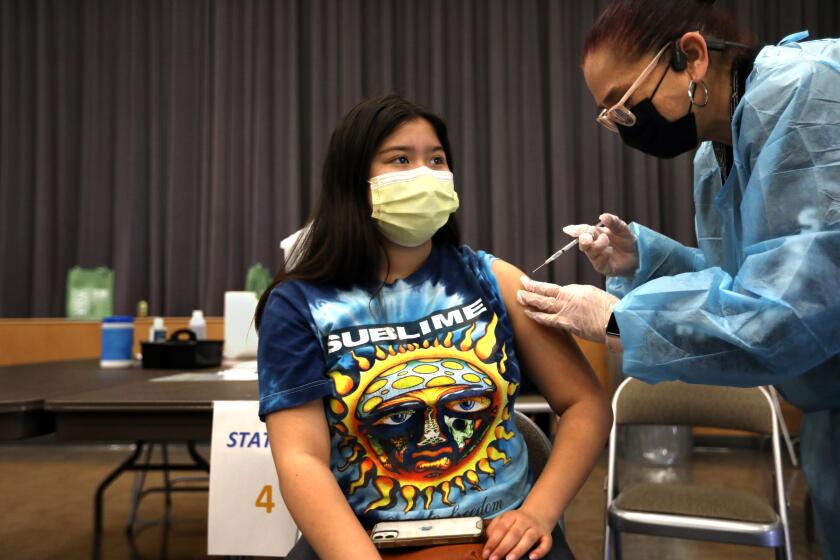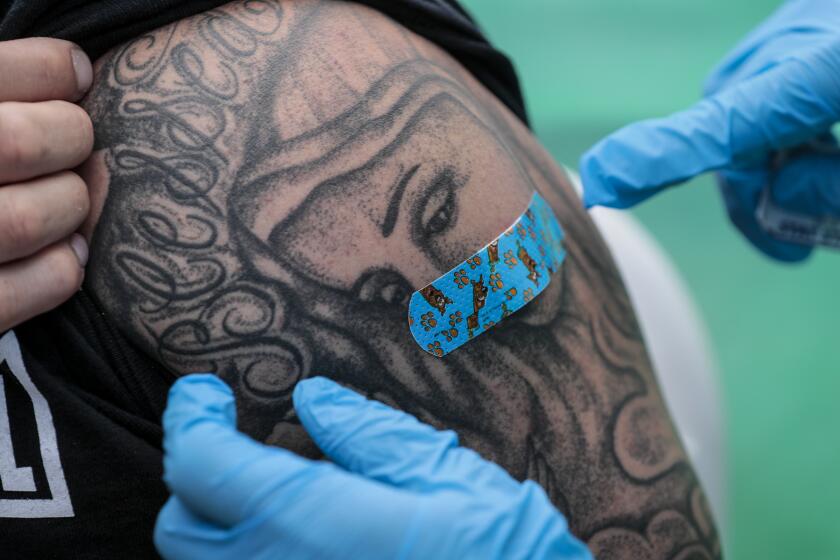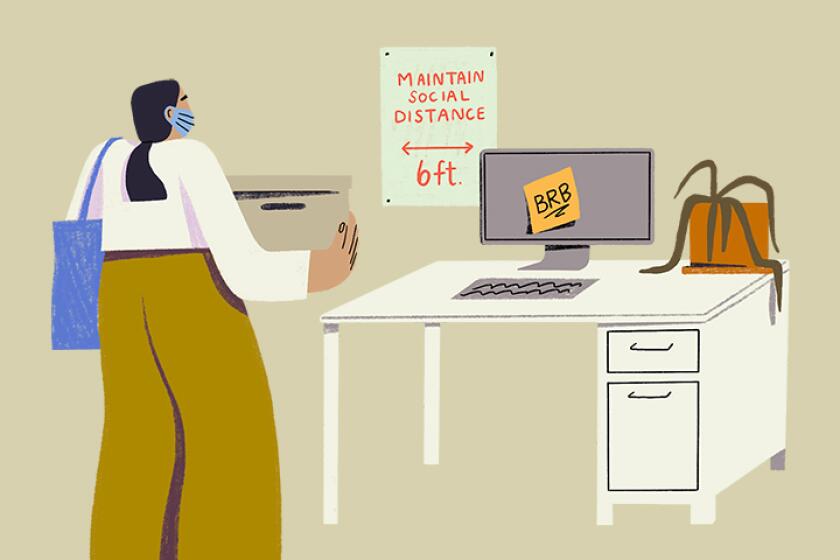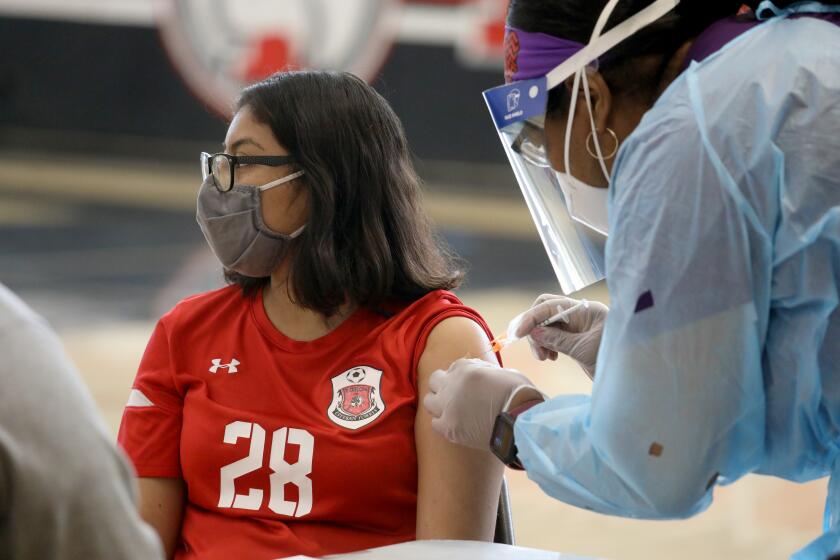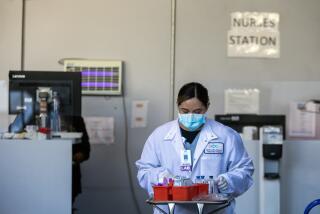California panel recommends ending mask rules for workers if every person in the room is vaccinated
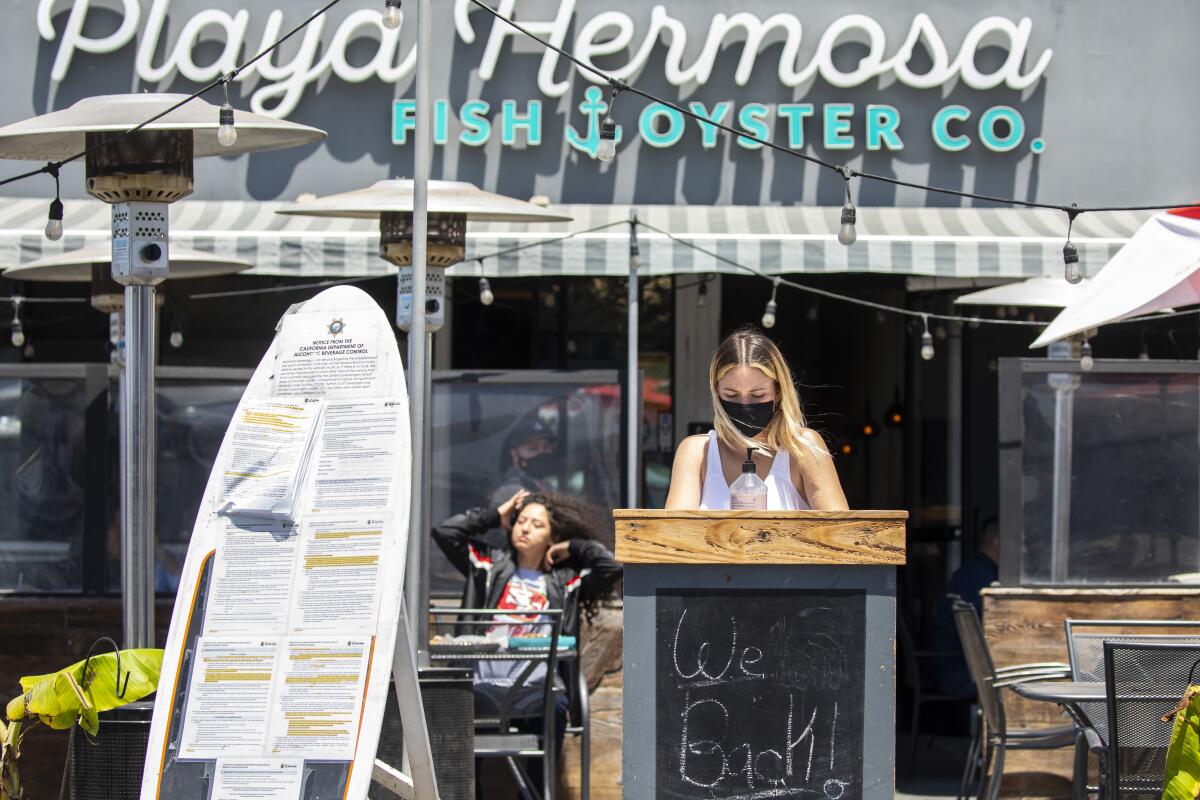
- Share via
A California safety board Thursday recommended relaxing workplace safety rules for people vaccinated against COVID-19, meaning that on June 15, employees will probably be able to take off their masks in a room if everyone there is vaccinated.
As the pandemic continues to wane and more people are inoculated against COVID-19, confidence has grown among officials that face coverings and social distancing are no longer a must for fully vaccinated Californians — though they remain important for those who have yet to roll up their sleeves.
That’s why the seven-member Occupational Safety and Health Standards Board, whose members are appointed by the governor, ultimately unanimously opted to push the rules forward, saying it was time to begin relaxing mask-wearing rules.
“We have seen great improvements in a lot of workplaces and we’ve seen numbers go down,” said board member Laura Stock, who is also director of UC Berkeley’s Labor Occupational Health Program. Now, where “people are vaccinated, there are certain things that actually can be changed.”
The new rules proposed by the California Division of Occupational Safety and Health, or Cal/OSHA, are still subject to review by the state Office of Administrative Law. But it’s expected the office will approve the rules, which can go into effect on June 15 — the same day as California is set to fully reopen its economy.
The rules would allow workers in a room to take off their masks if every person there is fully vaccinated and does not have COVID-19 symptoms. Masks would still be required if anyone in the room is not fully vaccinated.
Someone is considered fully vaccinated 14 days after receiving a second dose of the Pfizer-BioNTech or Moderna vaccines or the single shot of Johnson & Johnson. Workplaces would need to have workers’ vaccine records on file to comply with Cal/OSHA regulations.
But workers in places such as retail stores and restaurants, as well as others who interact with members of the public, will still need to mask up. Workers in some other settings, such as hospitals, will not be affected by the rule change.
The proposal also calls for ending the requirement that workers be physically distant from other people starting July 31. Until then, employees in indoor settings or outdoor events of 10,000 or more people will need to continue physical-distancing practices or be offered respirators — like N95 masks — that filter out fine particles in the air.
Other board members said they wanted the state to move faster, and to align with looser standards suggested for the public by the U.S. Centers for Disease Control and Prevention and, as of June 15, by the California Department of Public Health. Those standards say there’s no need for fully vaccinated people to wear masks in almost all settings.
The board voted to create a committee to work with Cal/OSHA to address the concerns of a majority of board members, who initially voted to reject Cal/OSHA’s proposal but ultimately approved it as board members agreed to work on a revision.
“I don’t think we’re in an emergency situation anymore,” said board member Chris Laszcz-Davis, a veteran corporate executive and a previous industrial hygiene engineer at Lawrence Livermore National Laboratories. “Personally, I would encourage that we align with the CDC guidelines a little more closely, because I know what we have suggested is more conservative.”
As the coronavirus fades, there is a growing belief among even the most conservative health experts that it’s fine for vaccinated people to largely shed their face coverings — though it’s still essential for the uninoculated to adhere to mask-wearing and physical distancing rules.
Before the board voted Thursday night, Gov. Gavin Newsom was asked at a media briefing in San Francisco if he would issue an executive order to further loosen mask standards beyond what the board approved.
“We’ll see where they went today. And I’ll have more to say after I read the final determination,” Newsom said.
Late Thursday night, a spokeswoman for the governor’s office, Erin Mellon, said in a statement that “we appreciate the board’s actions to maintain worker safety and are hopeful the board will further revise its guidance to reflect the latest science while continuing to protect workers and balancing realistic and enforceable requirements for employers.”
Thursday’s vote capped an extraordinary 9½-hour meeting — one of the longest and most contentious in recent memory.
Some employers were particularly vocal about one part of the proposal, which says that starting July 31, employers must make available a respirator, such as an N95 mask, for voluntary use by employees who are not fully vaccinated and work in indoor settings or outdoor settings with more than 10,000 people. Unvaccinated employees can still choose to wear a conventional mask.
“The N95 requirements ... are basically untenable.... There are concerns about cost and supply and access,” said board member Kate Crawford, also a safety and health director for construction company Hensel Phelps. “If you even get to the practical standpoint of, ‘Can the employers stockpile enough N95s quickly enough,’ will there become an impact on the supply chain to the healthcare workers?”
Northern counties -- including Tehama and Lassen -- have low vaccination rates and the state’s highest rate of infection.
Eric Berg, deputy chief of Cal/OSHA, said there is no longer a dramatic shortage of respirators that there was early in the pandemic. In fact, there is a big surplus of N95 respirators, so large that there are possibly millions of the devices available, with Honeywell, one of the nation’s leading suppliers, recently having to shut down one of their manufacturing lines due to lack of demand.
Some business representatives opposed Cal/OSHA’s proposal as being unnecessarily complicated and potentially drawing a distinction between the vaccinated and the unvaccinated that could essentially create two classes of workers and an environment where some employees were subject to harassment.
They worried that requirements could draw attention to private medical decisions to not get vaccinated.
“One of our members is considering placing stickers on ID badges to determine who is vaccinated and who is not. Many are considering creating separate floors,” said Helen Cleary, director of the Phylmar Regulatory Roundtable, a business coalition. “The unintended consequences of these provisions are serious and they cannot be understated. They have the potential to negatively impact thousands of workers in the state.”
Some labor representatives urged the board to not relax the mask standards at all.
False claims about COVID vaccines have spread on social media, earning some myth spreaders big money, a health official says: ‘Don’t get played.’
Taylor Jackson, a lobbyist with the California Nurses Assn., said preventing spread of the coronavirus is best achieved through many layers of protection, which includes masks.
“All of our protective measures should remain in place, in addition to vaccines,” Jackson said. “As much as we want it, this pandemic is not over.”
Armando Elenes, secretary treasurer of the United Farm Workers union, said that the current, more stringent rules aren’t enforced enough and that the proposed changes would put even more people at risk.
“Even with the mandates, right now, the employers aren’t following the rules, and nothing has happened,” Elenes said. “Employees, especially farmworkers, have been exposed themselves — out of necessity — to COVID. We have outbreaks in slaughterhouses and other food processing facilities, in the fields, major outbreaks.”
Elenes added that farmworkers are under increased pressure to provide for their households and in doing so risk their safety at facilities which are not fully enforcing current mandates.
Unfortunately, many “workers chose to continue working because they just feel the immediate need of their other bills, and everything else is right there in front of them; versus the possibility of something happening,” he said.
If you were vaccinated in L.A. County, you’ll have access to a digital vaccine record through Healthvana. It’s not a vaccine passport, though. There are also other ways to get your COVID-19 vaccination records.
Mitch Steiger, lobbyist with the California Labor Federation, said he was concerned about the proposed phase-out, at the end of July, of required partitions, such as the plastic barriers that place a barrier between customers and cashiers.
Still, Steiger urged the board to adopt the proposal as a compromise that still does a lot to protect workers. He said he was shocked at calls to do away with face coverings entirely or do away with emergency workplace standards entirely.
“People are still getting sick,” Steiger said. “Even though things statewide do seem to be heading in the right direction, it doesn’t mean that everything’s heading in the right direction in every county.… Work-related outbreaks are still happening as we speak, all across the state.”
Some of us are hoping that a year of remote work will lead to greater job flexibility. Others can’t wait to get out of the house.
One law expert said any workplace regulation related to COVID-19 — mask mandates, distancing or vaccination status — will be difficult to enforce, outside of public complaints filed to the health department.
“It’s onerous, it makes no sense, and it’s really up to the public and how they’re going to enforce this,” said Derek Tran, an attorney and founder of the Tran Firm, which focuses on employment law.
Tran said some of the proposed changes give mixed signals to workers and employers, who are already struggling to keep up with the state’s reopening process. That is especially so for restrictions, such as indoor physical distancing, proposed to stay in place until July 31 — well past the governor’s June 15 reopening date.
“Even as a lawyer, I find it confusing,” he said.
Some speakers Thursday noted that the proposed workplace rules were seemingly in conflict with what California would look like after June 15.
“A fully vaccinated server could work a lunch shift at a restaurant, get off work, go home, change out of their uniform, and then go out to dinner with their family or friends at the same restaurant in the evening and not be required to wear a mask — even though they had to wear a mask earlier in the day while at work,” said Katie Hansen with the California Restaurant Assn.
Michael Young, a lobbyist of the California Federation of Teachers, however, said the proposed standard “still provides significant protections to workers.”
There’s a “difference between members of the public willfully going to a restaurant or gym or other businesses, versus workers required to be physically present at a worksite,” Young said.
The suggested changes put forth by Cal/OSHA come less than two weeks before the state is set to widely relax its mask rules as part of its long-anticipated full reopening.
Starting June 15, California will align with the CDC’s recent mask guidance.
Existing state rules generally stipulate that everyone, such as members of the public in a retail store, needs to wear masks in indoor public settings. Workers are also required to wear face coverings and practice physical distancing unless they’re alone — either in a room or outside. Employees can remove their masks when eating or drinking but must be physically distant from others.
Officials said the decision to wait until June 15 to implement the CDC guidelines was based on giving residents more opportunities to get vaccinated and businesses and workers time to prepare for the change.
Still, the CDC’s May 13 announcement caught many off guard, and sparked some concerns that the nation was repeating the sins of its pandemic past and moving too quickly to relax restrictions.
Such fears have not materialized, however. Newly confirmed coronavirus infections have continued to tumble nationwide in recent weeks, as have COVID-19 hospitalizations and deaths.
In California, more than 70% of adults have now received at least one COVID-19 vaccine dose, according to data from the CDC.
One month ahead of the target date set by the Biden administration, California has now at least partially vaccinated 70% of its adult residents against COVID-19.
Although the state is still short of the 80% threshold many experts believe necessary to achieve long-lasting herd immunity against the coronavirus, the relatively robust level of vaccine coverage provides a strong level of protection, officials and experts say.
Local-level health officials can impose stricter rules than the state’s, but many counties — including Los Angeles — have indicated they plan to follow California’s lead come June 15.
L.A. County Public Health Director Barbara Ferrer said she thought the latest set of proposed workplace rules demonstrated that “at least for now, Cal/OSHA doesn’t want to take any chances with worker safety around the masking.”
“They’ve given some movement on both masking and on distancing, but they’ve made it clear that there’s an obligation for employers to ensure that there’s a lot of safety at the workplace, and that continues to mean adhering to some masking rules and some distancing rules at all of our work sites,” she said Wednesday.
As Occupational Safety and Health Standards Board agenda documents note: “A very large proportion of California employees will remain unvaccinated as of June 15.”
“Due to changes in social norms, as mask-wearing and physical distancing decline among fully vaccinated people, those precautions are likely to decline among unvaccinated and partially vaccinated people as well,” documents state. “Unvaccinated employees will therefore be particularly at risk, especially given the spread of especially contagious SARS-CoV-2 variants, unless protective measures are taken.”
Times interns Carly Olson and Andrew Mendez contributed to this report.
More to Read
Sign up for Essential California
The most important California stories and recommendations in your inbox every morning.
You may occasionally receive promotional content from the Los Angeles Times.
